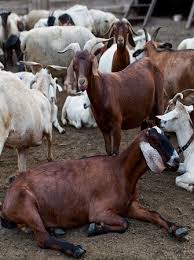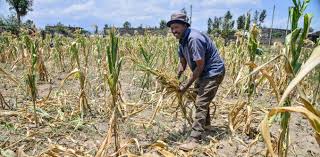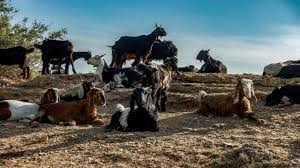In this article, the effects of climate factors on farm animals are discussed, focusing on their survival, performance, and productivity. The article also suggests livestock management strategies that can be adopted under changing climate conditions and offers coping strategies for farmers.
Effects of Climate Factors on Farm Animals
The livestock sector contributes to and is affected by climate change. Climate change impacts livestock both directly and indirectly. Direct effects, such as changes in air temperature, humidity, wind speed, and other climate factors, influence animal performance growth, milk production, wool production, and reproduction. The impact of climate change on animal production is categorized into:
1. Availability of feed grain
2. Pasture and forage crop production and quality
3. Health, growth, and reproduction
4. Disease and their spread
Animal health can be affected by climate change in four primary ways: heat-related diseases and stress, extreme weather events, adaptation of animal production systems to new environments.
The emergence or re-emergence of infectious diseases, particularly vector-borne diseases, which are critically dependent on environmental and climatic conditions. Livestock production is an integral part of mixed farming systems in developing countries.
Read Also: Sheep gene insights could help farmers breed healthier animals
Impact of Climate on Dairy Animals

Experimental studies have revealed that milk yield in crossbred cows (such as Karan Fries, Karan Swiss, and other Holstein and Jersey crosses) in India is negatively correlated with the temperature-humidity index. Local cows, more adapted to tropical climates, also show a similar response to climatic conditions.
The estimated annual loss due to heat stress among cattle and buffaloes in India is 1.8 million tonnes, representing nearly two percent of total milk production, valued at over Rs 2,661 crore (Upadhaya, 2010). While similar data for Nigeria is not available, similar trends can be expected in tropical climates.
Heat stress also has a detrimental effect on reproduction in buffaloes. Although buffaloes are morphologically and anatomically adapted to hot and humid climates, thermal stress can reduce estrus expression and conception rates.
During drought conditions, the length of the service and dry periods increases for all dairy animals. Disease outbreaks often correlate with the mass movement of animals, which is influenced by climatic factors.
There is an increased incidence of clinical mastitis in dairy animals during hot and humid weather due to heat stress and greater fly populations. Additionally, hot-humid conditions exacerbate the infestation of cattle ticks such as Boophilus microplus, Haemaphysalis bispinosa, and Hyalomma anatolicum.
Perceived Impact of Climate Factors on Livestock Sector
| S/N | Perceived Impact | Percentage (%) |
|---|---|---|
| 1 | Climate change affects agriculture and animal husbandry | 78 |
| 2 | Negative impact of climate change on productive performance | 58.3 |
| 3 | Negative impact on milk production | 56.6 |
| 4 | Negative impact on lactation length | 58.3 |
| 5 | Positive impact on dry period | 50.8 |
| 6 | Negative impact on reproductive performance | 36.3 |
| 7 | Decreased length and intensity of estrous period | 59.1 |
| 8 | Decreased conception rate | 57.5 |
| 9 | Effect on livestock disease incidences | 60.8 |
| 10 | Increased incidences of parasitic infestation in livestock | 83 |
| 11 | Feed and fodder resources are decreasing | 79.1 |
| 12 | Shortage of dry fodder | 95 |
| 13 | Decreased water resources | 95 |
| 14 | Depletion of groundwater levels | 82 |
| 15 | Decreased availability of water for irrigation | 69 |
| 16 | Decreased number of natural water resources | 77.5 |
Source: Singh et al. (2012). Climate Change Impacts on Livestock and Adaptation Strategies to Sustain Livestock Production, Vet. Adv. 2012, 2(7): 407 – 412.
Read Also: 17 Medicinal Health Benefits Of Mucuna pruriens (Monkey Tamarind)
Suggested Livestock Management Strategies Under Climate Change

Over centuries, livestock producers have adapted to climate changes based on their in-depth knowledge of the environment. Farmers’ perceptions and local traditional knowledge have allowed them to develop methods and techniques to cope with climate vagaries.
These methods, often locale-specific, require no external help and are inherently scientific. Documentation and sharing of such practices at larger platforms have influenced the research agendas of academic institutions.
Livestock Management Strategies Adopted by Farmers Under Climate Change
| S/N | Strategy | Percentage (%) | Rank |
|---|---|---|---|
| 1 | Change in livestock/herd composition (large to small animals) | 44 | X |
| 2 | Reduction in livestock numbers | 38 | XI |
| 3 | Replacement of exotic breeds with local breeds | 10 | XIV |
| 4 | Keeping more livestock and reducing reliance on crops | 48 | IX |
| 5 | Preservation of fodder | 90 | I |
| 6 | Crop diversification | 65 | V |
| 7 | New fodder crop variety/type | 60 | VI |
| 8 | Change in planting dates | 89 | II |
| 9 | Provide bedding for livestock during extreme winter/cold conditions | 79 | IV |
| 10 | Plantation of fodder tree lines around animal sheds to reduce heat/cold | 55 | VII |
| 11 | Selling livestock to buy food | 34 | XII |
| 12 | Migration with livestock during adverse climatic conditions | 53 | VIII |
| 13 | Livestock insurance | 27 | XIII |
| 14 | Transitioning from farming to non-farming occupations | 8 | XV |
| 15 | Rainwater harvesting | 5 | XVI |
| 16 | Traditional prayers | 81 | III |
Source: Singh et al. (2012). J. Vet. Adv. 2012, 2(7): 407 – 412.
Other Coping Strategies Adopted by Farmers
1. Providing cold water during hot and humid climates
2. Provision of shade to reduce heat stress
3. Providing fresh air or coolers during extreme hot conditions
4. Keeping animals outside during summer nights
5. Loose housing system for better ventilation
6. Allowing animals to roam freely in search of feed and safe spaces during harsh conditions
7. Elevated animal housing for better airflow
8. Constructing “Manchans” (hanging bamboo platforms) inside homes
9. Providing fire (alaw) in animal sheds during extreme cold
10. Rotational lopping of vegetative biomass from fodder trees, shrubs, and grasses
11. Promoting forest conservation and safe landing of running water during rains
Coping strategies can vary significantly based on region, support systems, and indigenous knowledge.
Climate change poses a serious threat to the livestock sector, impacting animal health, productivity, and farmer livelihoods. In countries like India, the government spends 2.5% of its GDP to address climate-related issues, but similar measures are yet to be implemented in Nigeria.
As livestock plays a vital role in the rural economy, it is essential to develop and implement strategies to mitigate the negative effects of climate change on livestock production.
Do you have any questions, suggestions, or contributions? If so, please feel free to use the comment box below to share your thoughts. We also encourage you to kindly share this information with others who might benefit from it. Since we can’t reach everyone at once, we truly appreciate your help in spreading the word. Thank you so much for your support and for sharing!

